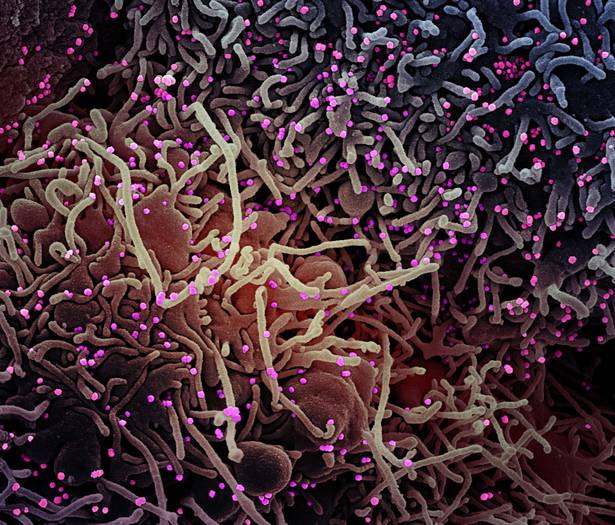Colorized scanning electron micrograph of a VERO E6 cell (purple) exhibiting elongated cell projections and signs of apoptosis, after infection with SARS-COV-2 virus particles (pink), which were isolated from a patient sample. Image credit: NIAID
A team at Quantitative Biosciences Institute Coronavirus Research Group (QCRG) is working to understand the plan of coronavirus so they can particularly treat them according to their strategy. They are first trying to find out what proteins the viruses are hijacking. To find this a team in the QCRG lab is examining human cells on a molecular level. They used baits - viral proteins with tiny chemical tags attached to them, put them into lab-grown human cells, and found the human protein that virus hijacks during infection. Already on March 2, 2020, the team had collected a partial list of human proteins that the coronavirus needs to flourish.
The team claimed that once they had this list of molecular targets the virus needs to survive, members of the team raced to identify known compounds that might bind to these targets and prevent the virus from using them to replicate. The team also maintains that if once a compound that can prevent the virus from copying itself in a person's body then the infection stops.
Further, instead of involving in developing a new drug that can cure CIVID-19, a team of researchers at Quantitative Biosciences Institute (QBI) at the University of California, San Francisco, are trying to discover how the virus attacks cells and first looking to see if there are any drugs available today that can disrupt these pathways and fight the coronavirus. They established QBI Coronavirus Research Group (QCRG) with a team of 22 labs that are working seven days a week, around the clock, and in shifts.
The chemists at the team are reachable to a massive database through which their aim is to find the drug that matches the approved drugs and proteins they interact with the proteins on our list. This process will save time and also a huge amount of funding as the traditional way involves years of pre-clinical study and clinical testing that also cost millions of dollars. The team has listed ten potential drugs that could halt the replication of coronavirus and by March 13, 2020, they have started the test of drugs in cells to see if they prevent the virus from reproducing. The team so far has found 50 existing drugs that bind the human proteins we've identified. This large number makes me hopeful that we'll be able to find a drug to treat COVID-19.
If the team finds an approved drug that even slows down the virus's progression, doctors should be able to start getting it to patients quickly and save lives.
